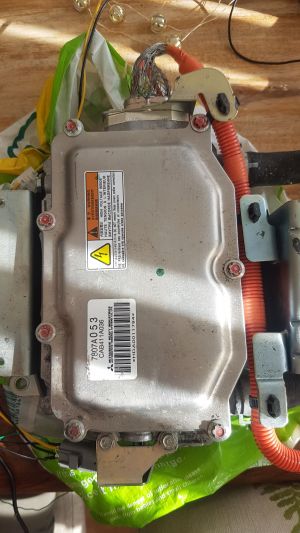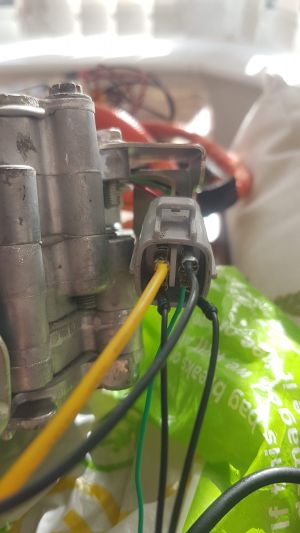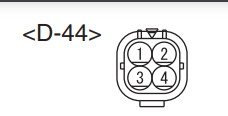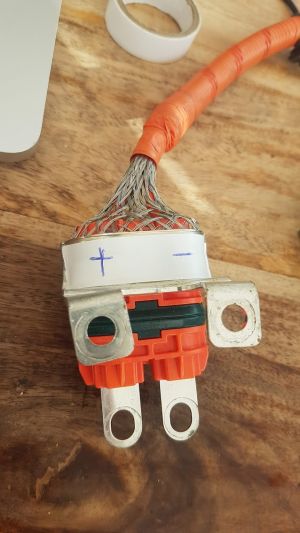Mitsubishi Outlander Water Heater: Difference between revisions
Added Gen 2 data |
No edit summary |
||
| (16 intermediate revisions by 7 users not shown) | |||
| Line 1: | Line 1: | ||
The Outlander PHEV has an optional electric water heater. This unit appears to be a 3rd generation (2011-2019 ish) http://www.mhi.co.jp/technology/review/pdf/e542/e542057.pdf. Specified as a 4kw unit. | The Outlander PHEV has an optional electric water heater. This unit appears to be a 3rd generation (2011-2019 ish) http://www.mhi.co.jp/technology/review/pdf/e542/e542057.pdf. Specified as a 4kw unit. | ||
The photo below is a Gen 3 heater and is CAN controlled. | The photo below is a Gen 3 heater and is CAN controlled. Example part number is 7807A007. | ||
Outlander Heater weighs 3,5kg | |||
[[File:20211011 113810.jpg|none|thumb]] | [[File:20211011 113810.jpg|none|thumb]] | ||
== Low Voltage Pinout (Gen 3) == | == Gen 3 (2016-2019) == | ||
====== Low Voltage Pinout (Gen 3) ====== | |||
[[File:20211011 113847.jpg|none|thumb]] | [[File:20211011 113847.jpg|none|thumb]] | ||
Top row, yellow is 12+, black is GND. | Top row, yellow is 12+, black is GND. | ||
| Line 11: | Line 14: | ||
Bottom row, under the yellow is Can H and under GND is Can L | Bottom row, under the yellow is Can H and under GND is Can L | ||
The mating connector | The mating connector is Sumitomo 6189-0126 https://www.auto-click.co.uk/6189-0126?search=90980-10942 and the wiring is the same as the AC Compressor. | ||
[[File:Heater Connector Pins.png|none|thumb|1 - 12v, 2 - GND, 3 - CAN H, 4 - CAN L]] | |||
== High Voltage Pinout == | ====== High Voltage Pinout ====== | ||
[[File:Outlander Heater HV.jpg|none|thumb]] | [[File:Outlander Heater HV.jpg|none|thumb]] | ||
== Can Messages from Heater (Gen 3) == | ====== Can Messages from Heater (Gen 3) ====== | ||
A Work In Progress DBC file is here https://github.com/jamiejones85/DBC-files/blob/master/OutlanderWaterHeater.dbc | |||
When 12v is connected, without HV, the following messages are broadcast: | When 12v is connected, without HV, the following messages are broadcast: | ||
0x398 ID 00 09 00 3B 3B 00 00 00 at 100ms byte 3 seems to be water temperature, byte 4 | 0x398 ID 00 09 00 3B 3B 00 00 00 at 100ms byte 3 seems to be water temperature inlet, byte 4 water temperature outlet | ||
0x630 ID 00 00 00 00 00 00 00 00 at 500ms | 0x630 ID 00 00 00 00 00 00 00 00 at 500ms | ||
| Line 28: | Line 34: | ||
0x398 ID 00 00 00 3B 3B 00 00 00 at 100ms | 0x398 ID 00 00 00 3B 3B 00 00 00 at 100ms | ||
== Control Can Messages == | ====== Control Can Messages ====== | ||
0x188 with below will turn the heater on 100ms or 500ms seem to work, as long as the 0x285 message is also broadcast. 0x285 is a general HV status message it seems | |||
03 50 A2 4D 00 00 00 00 | |||
0x285 at 10ms intervals | |||
0x00 0x00 0x14 0x21 0x90 0xFE 0x0C 0x10 | |||
A simple Ardunio sketch to control it is here: https://github.com/jamiejones85/OutlanderHeaterControl it uses a pot connected to A0, the first few degrees of turn the heater is off, above that it sets the temperature. The program watches the temperature reported by the heater, if it's below the desired it turns it on. Simple. | |||
Another heater control implementation is https://github.com/jamiejones85/RPI-PICO-Outlander-HVAC | |||
====== Measurements ====== | |||
12V consumption: 60mA regardless of what is happening | |||
Measured power at 0x32 power value: 1.4kW (at 267V) | |||
Measured power at 0xa2 power value: 3.5kW (at 267V) | |||
== Gen 2 (2011 - 2016) == | == Gen 2 (2011 - 2016) == | ||
The Previous generation of water heater is larger and heavier than the Gen 3, part number 7807A007. Controlled via external ECU rather than CAN. | The Previous generation of water heater is larger and heavier than the Gen 3, part number 7807A007. Controlled via external ECU rather than CAN. | ||
====== Low Voltage pinout ====== | ====== Low Voltage pinout and control ====== | ||
# +12v (Red) | # +12v (Red) | ||
| Line 44: | Line 65: | ||
# Outlet temp (White) | # Outlet temp (White) | ||
# Inlet Temp (Grey) | # Inlet Temp (Grey) | ||
When HTR1-3 are grounded the heater will activate. The more inputs that are grounded the higher the power output. Power output ramps up quite slowly. | |||
Low Voltage connector looks to be a Sumitomo TS 8 way connector. Commonly used in Japanese motorcycle looms. | |||
'''Temperature''' | |||
Input and output temperatures are resistance based. Some rough data has been gathered on resistances at some given temperatures. | |||
97000 Ohms at 12c | |||
30000 Ohms at 42c | |||
16500 Ohms at 58c | |||
Using this data the Calculated Steinhart-Hart model coefficients are: | |||
A= 1.161003704 e-3 | |||
B= 1.616884180 e-4 | |||
C= 3.151304262 e-7. | |||
With this data it is possible to read the temperature from the sensor with an Arduino sketch. | |||
====== High Voltage connector ====== | ====== High Voltage connector ====== | ||
Same as Gen 3 in appearance and polarity. | Same as Gen 3 in appearance and polarity. | ||
[[Category:Mitsubishi]] | |||
[[Category:Heater Coolant]] | |||
Latest revision as of 17:45, 30 October 2025
The Outlander PHEV has an optional electric water heater. This unit appears to be a 3rd generation (2011-2019 ish) http://www.mhi.co.jp/technology/review/pdf/e542/e542057.pdf. Specified as a 4kw unit.
The photo below is a Gen 3 heater and is CAN controlled. Example part number is 7807A007. Outlander Heater weighs 3,5kg

Gen 3 (2016-2019)
Low Voltage Pinout (Gen 3)

Top row, yellow is 12+, black is GND.
Bottom row, under the yellow is Can H and under GND is Can L
The mating connector is Sumitomo 6189-0126 https://www.auto-click.co.uk/6189-0126?search=90980-10942 and the wiring is the same as the AC Compressor.

High Voltage Pinout

Can Messages from Heater (Gen 3)
A Work In Progress DBC file is here https://github.com/jamiejones85/DBC-files/blob/master/OutlanderWaterHeater.dbc
When 12v is connected, without HV, the following messages are broadcast:
0x398 ID 00 09 00 3B 3B 00 00 00 at 100ms byte 3 seems to be water temperature inlet, byte 4 water temperature outlet
0x630 ID 00 00 00 00 00 00 00 00 at 500ms
0x062D ID 00 00 00 00 00 00 00 00 at 500ms
0x06BD ID 00 00 00 00 00 00 00 00 at 500ms
When HV is connected 0x398 changes to the message below.
0x398 ID 00 00 00 3B 3B 00 00 00 at 100ms
Control Can Messages
0x188 with below will turn the heater on 100ms or 500ms seem to work, as long as the 0x285 message is also broadcast. 0x285 is a general HV status message it seems
03 50 A2 4D 00 00 00 00
0x285 at 10ms intervals
0x00 0x00 0x14 0x21 0x90 0xFE 0x0C 0x10
A simple Ardunio sketch to control it is here: https://github.com/jamiejones85/OutlanderHeaterControl it uses a pot connected to A0, the first few degrees of turn the heater is off, above that it sets the temperature. The program watches the temperature reported by the heater, if it's below the desired it turns it on. Simple.
Another heater control implementation is https://github.com/jamiejones85/RPI-PICO-Outlander-HVAC
Measurements
12V consumption: 60mA regardless of what is happening
Measured power at 0x32 power value: 1.4kW (at 267V)
Measured power at 0xa2 power value: 3.5kW (at 267V)
Gen 2 (2011 - 2016)
The Previous generation of water heater is larger and heavier than the Gen 3, part number 7807A007. Controlled via external ECU rather than CAN.
Low Voltage pinout and control
- +12v (Red)
- None
- HTR1 (green)
- HTR2 (yellow)
- HTR3 (Orange)
- Ground (Black)
- Outlet temp (White)
- Inlet Temp (Grey)
When HTR1-3 are grounded the heater will activate. The more inputs that are grounded the higher the power output. Power output ramps up quite slowly.
Low Voltage connector looks to be a Sumitomo TS 8 way connector. Commonly used in Japanese motorcycle looms.
Temperature
Input and output temperatures are resistance based. Some rough data has been gathered on resistances at some given temperatures.
97000 Ohms at 12c
30000 Ohms at 42c
16500 Ohms at 58c
Using this data the Calculated Steinhart-Hart model coefficients are:
A= 1.161003704 e-3
B= 1.616884180 e-4
C= 3.151304262 e-7.
With this data it is possible to read the temperature from the sensor with an Arduino sketch.
High Voltage connector
Same as Gen 3 in appearance and polarity.